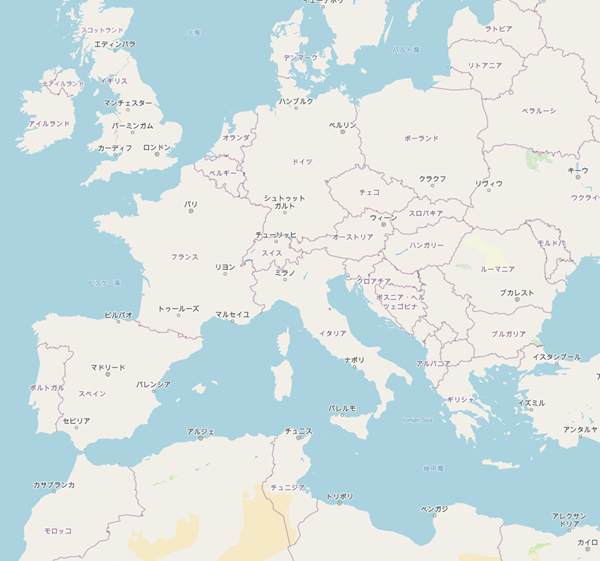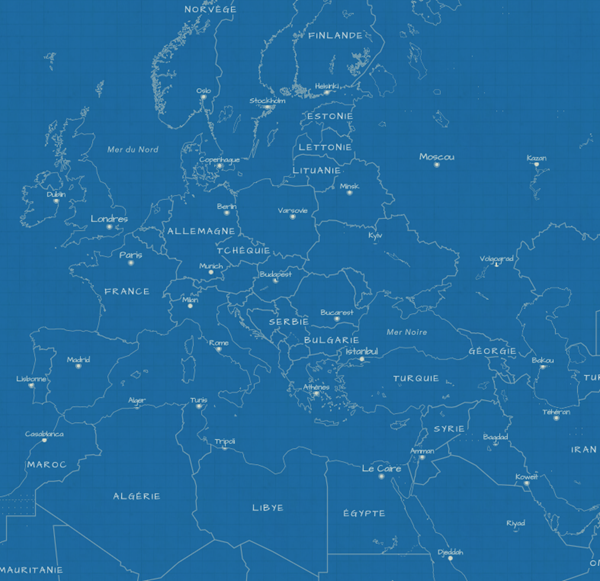ArcGIS Data Appliance: Open Vector Basemaps supports localizing select map labels into the languages listed below. The default map displays an English-label map, as supported by the data. Localization is another form of basemap customization. As with other customization, there are two main ways to create a style for customization: add a style to the map in the ArcGIS Vector Tile Style Editor or copy a root.json style from the USB flash drive. Review the information in the previous section on how to customize Open Vector Basemap styles.
Localization changes the labels on the map for a select number of mainly small-scale features when the data supports it. Localize the map by changing the "text-field" value of the map style's resources\styles\root.json file. Use the corresponding codes for the language you want to display. It is also recommended that you change all "text-font" values to an Arial Unicode font ("Arial Unicode MS Regular" or "Arial Unicode MS Bold") to allow all glyphs to display on the map or apply the Unicode font as part of a fallback font stack. After the localization changes are applied to your JSON, validate the JSON using JSONLint or a similar tool, and update or upload the new localized map style. The edits can also be applied on the JSON through the ArcGIS Vector Tile Style Editor.
Languages and codes supported in ArcGIS Data Appliance 2026
The following language codes are supported in ArcGIS Data Appliance 2026: Open Vector Basemaps:
| Language | Code |
|---|---|
Arabic | ar |
Bosnian | bs |
Bulgarian | bg |
Catalan | ca |
Croatian | hr |
Czech | cs |
Danish | da |
Dutch | nl |
English | en |
Estonian | et |
Finnish | fi |
French | fr |
German | de |
Greek | el |
Hebrew | he |
Hungarian | hu |
Indonesian | id |
Italian | it |
Japanese | ja |
Korean | ko |
Latvian | lv |
Lithuanian | lt |
Norwegian | no |
Polish | pl |
Portuguese (Brazil) | pt_b |
Portuguese (Portugal) | pt_p |
Romanian | ro |
Russian | ru |
Serbian | sr |
Slovak | sk |
Slovenian | sl |
Spanish | es |
Swedish | sv |
Thai | th |
Turkish | tr |
Ukrainian | uk |
Vietnamese | vi |
Features supported for localization
The following features in Open Vector Basemaps can have their "text-field" values changed to support these languages. The map labels that can be localized are primarily features displayed at small scale. The default JSON labels the map in English "{_name}". You can change it to the localized language "{_name_XX}". Using the ArcGIS Vector Tile Style Editor or a text editor, find each "id" name and change its "text-field" value accordingly.
For example, to display the map in Japanese, the JSON for each of these features changes "text-field": "{_name}" to "text-field": "{name_ja}", for French, "text-field": "{name_fr}", and so on.
| Open Basemap styles (except Blueprint) | Open Basemap Blueprint |
|---|---|
id : "coastal water area/label/bay", | id : "coastal water area/label/bay", |
id : "coastal water area/label/sea", | id : "coastal water area/label/sea", |
id : "coastal water area/label/strait", | id : "coastal water area/label/strait", |
id : "coastal water point/sea", | id : "coastal water point/sea", |
id : "coastal water point/strait", | id : "coastal water point/strait", |
id : "water area/label/lake or pond (perennial)", | id : "water area/label/lake or pond (perennial)", |
id : "water area/label/large lake", | id : "water area/label/large lake", |
id : "ocean point", | id : "ocean point", |
id : "admin 1", | id : "admin 1", |
id : "town/non capital", | id : "town/non other capital", |
id : "town/admin 2 capital", | n/a |
id : "town/admin 1 capital", | n/a |
id : "town/country capital", | id : "town/country capital", |
id : "small city/non capital", | id : "small city/non other capital", |
id : "small city/admin 2 capital", | n/a |
id : "small city/admin 1 capital", | n/a |
id : "small city/country capital", | id : "small city/country capital", |
id : "medium city/non capital", | id : "medium city/non other capital", |
id : "medium city/admin 2 capital", | n/a |
id : "medium city/admin 1 capital", | n/a |
id : "medium city/country capital", | id : "medium city/country capital", |
id : "large city/non capital", | id : "large city/non other capital", |
id : "large city/admin 2 capital", | n/a |
id : "large city/admin 1 capital", | n/a |
id : "large city/country capital", | id : "large city/country capital", |
id : "extra large city/non capital", | id : "extra large city/non other capital", |
id : "extra large city/admin 2 capital", | n/a |
id : "extra large city/admin 1 capital", | n/a |
id : "extra large city/country capital", | id : "extra large city/country capital", |
id : "mega city/non capital", | id : "mega city/non other capital", |
id : "mega city/admin 2 capital", | n/a |
id : "mega city/admin 1 capital", | n/a |
id : "mega city/country capital", | id : "mega city/country capital", |
id : "country/small", | id : "country/small", |
id : "country/medium", | id : "country/medium", |
id : "country/large", | id : "country/large", |
Other features
There are other features on the map with "text-field": "{_name}" in the JSON file. These features do not support localization; do not change their JSON code. Only those in the table above are supported.
Changing the font
It is recommended that you change the fonts to Arial Unicode MS (bold or regular), especially for languages such as Cyrillic, Japanese, or Arabic. Open Vector Basemap styles can have different default fonts. For example, the default font for Blueprint style is Architect's Daughter. For the light gray canvas style, the default fonts are in the Noto Sans family. Refer to the font list in the ArcGIS Data Appliance: Esri Vector Basemap Reference Document (v2) PDF in the Additional resources for Open Vector Basemaps topic for complete details. Change the fonts to "text-font" : ["Arial Unicode MS Regular"]. Fonts that are bold by default can be changed to "text-font" : ["Arial Unicode MS Bold"]. There is no italic font in the Arial Unicode family.


Additional JSON edits for Arabic language maps
To ensure that Arabic glyphs appear correctly on the map, either set the text-spacing setting to 0 (zero) or completely remove the "text-letter-spacing" style attribute from the root.json file. JSON styles may display this attribute as follows:
"text-letter-spacing" : 0.05,
Or the style may have more complex syntax such as the following:
"text-letter-spacing" :
{ "stops" : [[4, 0.1], [8, 0.18]] }
Either change these to "text-letter-spacing" : 0, or remove the lines completely. Be sure to validate any root.json before updating the file on your portal.